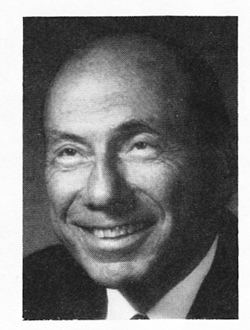THE EDITOR'S CORNER
This year's Symposium on Craniofacial Growth at the University of Michigan Center for Human Growth and Development assembled the usual glittering group of presenters and discussors and an overflow crowd of distinguished attendees to examine the biological basis of functional appliance therapy. While this was not a clinical symposium, there were a number of clinically significant remarks. To avoid the risk of misquotation, name attribution will be omitted from the following ideas and comments selected from the Editor's notebook.
Since human subjects cannot be sacrificed and their tissues studied histologically for growth changes, we still seem to be dependent upon the work of Dr. Alexandre Petrovic on rats and Dr. James McNamara and Dr. Egil Harvold on monkeys for a great deal of the basic scientific evidence of change produced by functional appliance therapy. One participant allowed that some of his patients were rats, but not many; and that it was something of a leap of faith to accept the idea that what works in rats and in monkeys also works in humans. Yet, there was general agreement that if almost any functional appliance is worn by a human patient, something happens; but that different things happen with different people.
The differences are attributed to differences in appliance design; patient cooperation; and individual differences in growth timing and in muscular, neuromuscular, cellular, and biochemical maturation about which more information is needed. Each individual is viewed as a unique and changing biological system, with individual variations and adaptions; so that one can't expect the same response in every case, and individual patient response determines the results. So basically it is a tissue response, and not all individuals respond the same. A question was raised whether the response was more variable than the appliance. Well, the appliances are different and we probably cannot extrapolate from one to the other. Some are passive appliances, and some have an active element. The Frankel appliance and the LSU activator are the only tissue-borne appliances. The rest are tooth- and tissue-borne or, as in the case of the Herbst appliance, entirely tooth-borne. There is also great variation in the fabrication of the "name" appliances, which can greatly influence the response. Some are worn all the time, and some at home and at night only. There is some scientific evidence that the LSU activator is more effective when worn 12-14 hours in the evening and at night, than when worn for 22 hours; while the Frankel appliance is more effective when worn full time. The residual activator effect is something of a mystery, as is the unpredictability of the response. It was reported that one-half of the cases got mandibular advancement, while one-half got maxillary retrusion, with no way to predict which one to expect. A Harvold activator is intended to hold the mandible in centric relation, while a Frankel postures the mandible forward. No significant studies of bionators, Bimlers, or some of the other functional appliances were referred to. In most cases they seem not to exist.
While the mandible normally outgrows the maxilla by 2mm a year on the average, changes during functional appliance therapy are not limited to increased mandibular length. Concentration on scientific evidence that functional appliances can grow mandibles beyond the individual expectation in growth is not appropriate. Other changes occur in muscle, bone, teeth small relative changes in the inclination of incisors and the Harvold effect on molars - and posture. Airway is related to mandibular posture and improving the airway may result in counterclockwise rotation of the mandible moving pogonion forward. So, there may actually be pretty small changes in the condyle, plus an accumulation of other small changes to produce a significant net effect. We are reminded that Dr. Melvin Moss described orthodontics as a 6mm profession.
Insufficient work has been done on condylar position and condylar growth in humans, but there is some evidence of condylar remodeling and of glenoid fossa remodeling. Most users of functional appliances seem agreed that they work well on a percentage of carefully selected cooperative, nonextraction, brachyfacial cases; and they use functional appliances on 15-20% of the cases in their practices. Failure rates on unselected cases can reach 50%. Selection on a dental or skeletal basis can be overridden by the cooperation factor, and once the patient leaves the office we don't really know about full-time or part-time appliance wear. Another problem in judging the efficacy of appliances is a tendency to report only successful cases, cases that grew well.
Overlaid on the whole question of what functional appliances may do and how they may do it is a question of measurement. Some creativity goes into the tracing of many cephalometric films. There is danger in comparing films taken at different distances and with different machines. Posturing changes may create differences greater than all the other changes combined. Linear cephalometric measurements in two dimensions cannot measure shape changes in three dimensions, but we need to know how changes take place before we can assign appliances to correct them. Nevertheless, there seems to be a consensus that the clinician must decide what each patient needs, establish treatment objectives, and use different appliances for different objectives.
Our European colleagues look upon the renewed interest in functional appliances in the United States with a touch of deja vu, with a certain amount of skepticism, but also with a wistful parental wish that a fresh approach may improve the understanding of an old problem.
The title of this symposium was "The Clinical Alteration of the Growing Face". It is expected that the proceedings will be published in book form. Those who are interested in obtaining the book should write to: Publication Office, Center for Human Growth and Development, The University of Michigan, 1111 E. Catherine, Ann Arbor, Michigan 48109.


